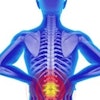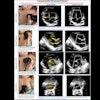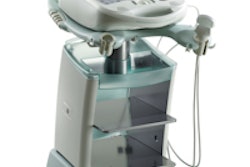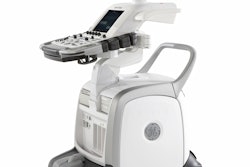
NEW ORLEANS - An intravascular ultrasound (IVUS)-guided clinical trial determined that while atheroma volume in the coronary arteries regressed with rosiglitazone (Avandia) and increased with the sulfonyurea glipizide, the difference failed to reach statistical significance.
The APPROACH (Assessment on the Prevention of Progression by Rosiglitazone On Atherosclerosis in diabetes patients with Cardiovascular History) trial, presented at the recent American Heart Association (AHA) Scientific Sessions 2008, included 672 patients who were undergoing either coronary angiography or percutaneous coronary interventions.
Researchers selected a region of interest in the coronary arteries -- an area that was not subject to an intervention -- and using a motorized pullback technique examined a 40-mm segment of the artery. Total atheroma volume was measured, and all acquired intravascular ultrasound frames were analyzed longitudinally.
Dr. Richard Nesto, associate professor of cardiovascular medicine at the Lahey Clinic in Burlington, MA, said that eventually 462 of the patients who underwent a second IVUS examination had their arteries analyzed to determine the percentage of atheroma volume in the same segment after 18 months of therapy with the drugs.
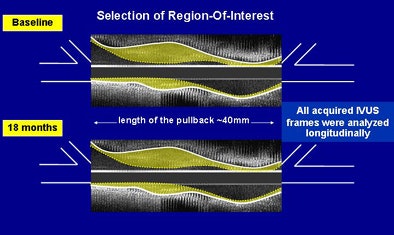 |
| IVUS analysis was performed by a blinded core lab (Cardialysis, Rotterdam, the Netherlands) on the same region of interest at baseline and at 18 months following initiation of the drug. The researchers measured the change in percent of atheroma volume, the change in normalized total atheroma volume, and the change in atheroma volume in the most diseased 10-mm segment. Images courtesy of Dr. Richard Nesto. |
The percentage of atheroma volume had decreased 0.21% in the patients taking rosiglitazone compared with a 0.43% increase among patients taking glipizide. The difference between the two groups did not reach statistical significance (p = 0.12). In addition, neither the reduction from baseline for rosiglitazone (p = 0.53) nor the increase from baseline among the glipizide patients (p = 0.19) achieved statistical significance, he said.
"The study supports but does not prove the hypothesis that rosiglitazone has a greater antiatherosclerotic effect than glipizide in patients with type 2 diabetes," Nesto said.
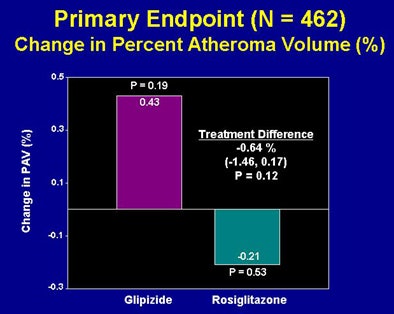 |
| Results of the randomized comparison of two drugs (top and bottom) in 462 patients support the hypothesis that rosiglitazone (teal bars) has a greater antiatherosclerotic effect than glipizide (purple bars) in patients with type 2 diabetes; however, the results did not reach statistical significance. Compared with glipizide, allocation of rosiglitazone led to a nonsignificant reduction in the primary outcome of percent atheroma volume (p = 0.12), a significant reduction in the secondary outcome of normalized total atheroma volume (p = 0.04), and a nonsignificant reduction in the secondary outcome of atheroma volume in the worst 10-mm segment (p = 0.13). Data and images courtesy of Dr. Richard Nesto. |
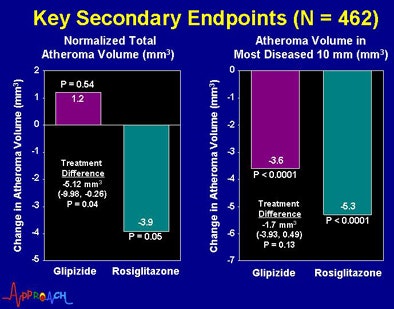 |
Jeff McLaughlin, a spokesperson for GlaxoSmithKline, the company that sponsored the APPROACH trial, said in a statement that "in terms of safety, there were no unexpected differences between Avandia and glipizide. The overall incidence of cardiovascular events was comparable between groups, although the study was not powered to evaluate clinical outcomes."
According to Nesto, the direction of the differences was similar to an IVUS trial of glimepiride and pioglitazone (Actos), but in that study the differences did reach significance.
Patients in both arms of the study gained weight while in the 18-month trial, Nesto said. The weight gain was about 2 kg among the glipizide patients and about 4.5 kg for patients on rosiglitazone.
By Edward Susman
AuntMinnie.com contributing writer
November 14, 2008
Related Reading
MRI shows prowess in diabetic foot with osteomyelitis, November 10, 2008
Diabetes linked to accelerated atherosclerotic plaque progression, August 11, 2008
Diabetes type affects outcomes after hip and knee arthroplasty, March 6, 2008
Ultrasound detects foot muscle atrophy in diabetics, December 26, 2007
Copyright © 2008 AuntMinnie.com

